Microphone measurement and sound check
First of all, we can also measure the frequency range of the microphone to accommodate the feedback of the readers. For this we use our measuring room again, but we virtually reverse the process. Of course, a true reciprocity calibration as a starting point exceeds our current possibilities and the effort far exceeds the benefits. That is why we have sought a compromise.
However, since we have a calibrated measuring microphone, a comparison measurement and the calculation of the differences can at least produce a curve that is easily usable for our purpose. So it is not the exact frequency response of the microphone, we would not presume that, but a meaningful approximation, which also underpins our subjective impression.
The low-cut at 100 Hz is measurable, but the upper range ends at approx. 8 KHz before the total crash occurs. Thus, the manufacturer's specification of 18 KHz is rather misleading, even if you don't need the super high tone at all. But it could have been up to 10 KHz. I had this effect in both measurements, also in the post-test, so I have to leave this statement to stand.
First measurement
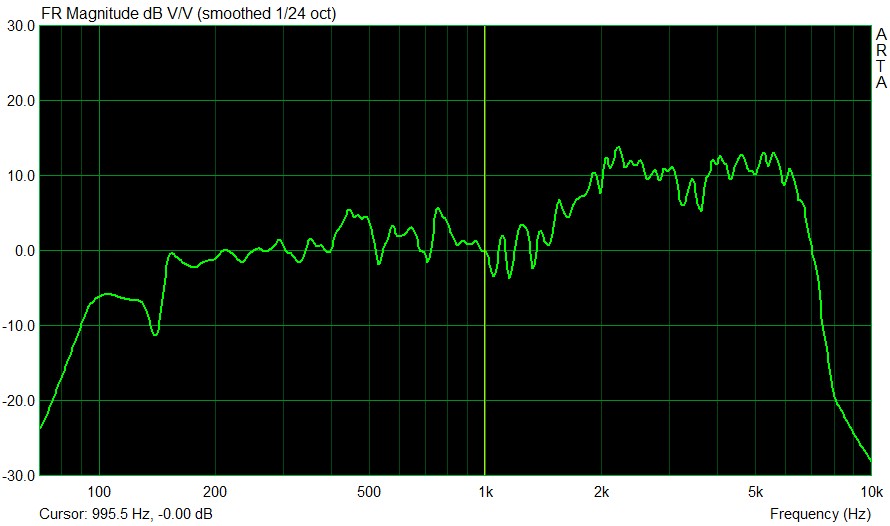
Second Mmeasurement
Here I deliberately left the range up to 20 KHz in the diagram, so that you can see where the superhochton has remained. This doesn't look any better at first glance (but sounds weirdly better):

Since the installed electret microphone depends on a small supply voltage, sensitivity and noise signal distance are also very much dependent on the microphone input. Three motherboards, three measurements. The Aorus X299 Master performed best here, followed by two Z390 motherboards from MSI. On a budget motherboard from ASRock, on the other hand, there was the end of terrain and it roared to god-barmen. So please don't always put everything on the hardware.
It's a different thing with the sound, because it's really not optimal. For this test, I deliberately sat in front of the monitor in the normal room, just like a player would sit. The influence of the room reverberation is extreme when compared to that of an open large-diaphragm condenser microphone (kidney). I discussed both microphones in the same position and with the same distance to stay really comparable.
Original with condenser microphone (the t.bone)
Sennheiser GSP 600 – First Test
Sennheiser GSP 600 – Post-test
Overall, the resolution is only mediocre, although I wouldn't describe the noise on a neat motherboard as higher than other headsets. In the first test, the sound characteristic had the charm of a bucket and was very dull. The second recording sounds better, but abundantly flat and it remains free of any dynamics. But the comprehensibility has increased and it is already a big difference and also the reason why I take the trouble to get a fair update in the end.
But it also shows very clearly how well (or how much better) you can also use a neat table microphone for approx. 100 euros. The t.bone is an acceptable and very level-resistant vocal microphone, which is also available with USB connection.
Headphone measurement
As we test, we have already explained in the basic article "Gaming Headsets: Myth, Truth and How we Test" very detailed and transparent, because with the usual audio-swirl of bass thunderstorms and high-pitched whips you can't really get any further. You have to be able to listen subjectively well and measure at the same time. Let us start with the latter.
Let's move on to measuring the quality of the headphones. I have again normalized the frequency curve at 1 KHz to 0 dB, so that on the one hand one can evaluate the overall course with all encores and frequency waste and on the other hand not completely loses the possibility of comparison to previous measurements. But it is still different, because the smoothing (1/1 octave) is supplemented by the almost unsmoothed representation (1/24 octave). Of course, all of this looks much more "hilarious", but also fits much better with reality. Because one thing is also clear: it does not exist, the ideal curve.
But let's start with the smoothed curve, because it's easier to explain. What we see is not a typical bathtub, which is very pleasing. Below a KHz, one records an audible level drop in the bass, which could be compensated very well with an increase of the ranges from 500 Hz downwards. At the analog equalizer of the test room, I was even able to force something like a linear playback between 24 Hz and 22 KHz without sacrothinging a great deal of level strength.
This in turn shows that the mechanical sounding (see Tear Down on the previous page) was designed more for the gamer and not for gangsta rap-obsessed bass fetishists. However, the headset can be bass, even raven black and precise, but you have to help a little if necessary. The level strength is good, but for the 115 dB with good classic (HDR) you need well over 1.3 volt smandy, which in turn requires a very good headphone amplifier. The in-house GSX 1000 can do nothing with the GSP 600 or vice versa, the GSP 600 is so brutally slowed down by the GSX 1000 that you want to run away. Too bad.
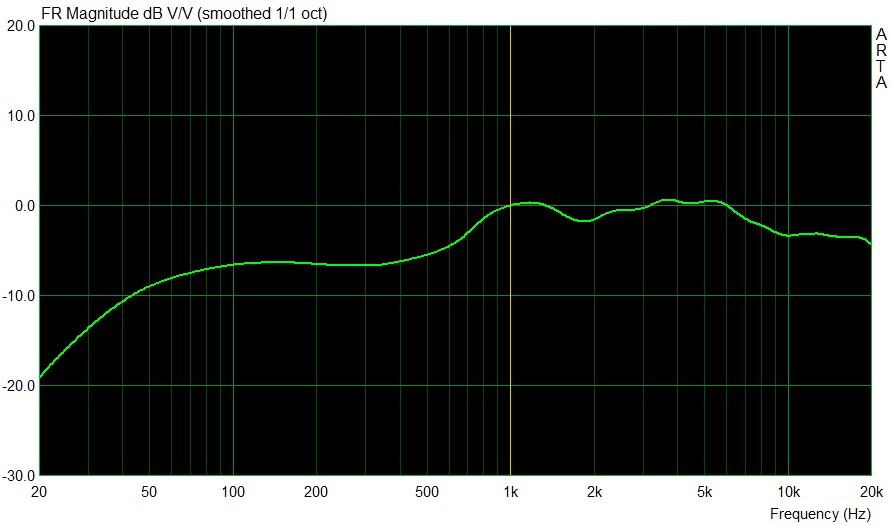
Now let's put aside the PR-compatible display and look at the unsmoothed curve. Of course, the "only" semi-professional measuring equipment also plays a role here, but nevertheless the measured is very similar here as well. We can see here once again more clearly that the rather mid- and height-heavy design of the headset is intended for e-sports. But here, too, the manufacturer's information on the data sheet has been made very consciously without specifying the tolerance range. Sennheiser must accept this criticism.
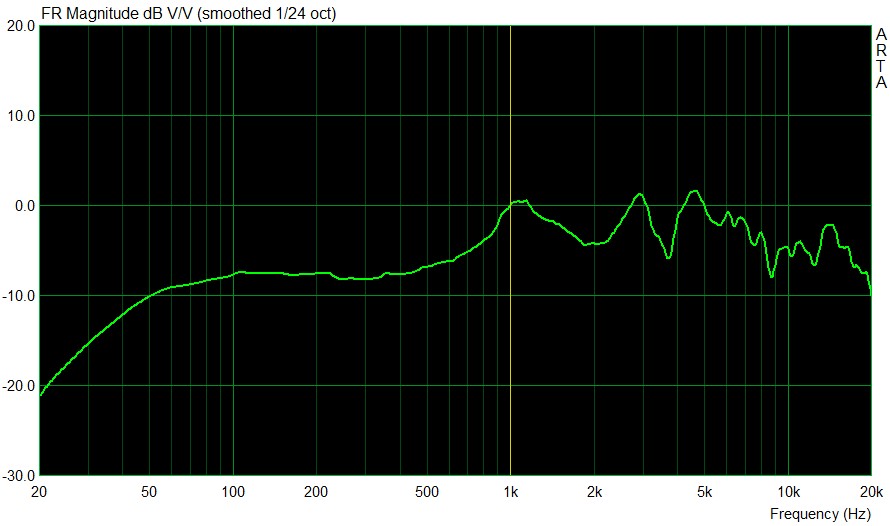
Cumulative Spectra (CSD and SFT)
The cumulative spectrum denotes different types of diagrams that show time-frequency properties of the signal. They are generated by successive application of the Fourier transformation and suitable windows to overlapping signal blocks. These analyses are based on the frequency response diagram already shown above, but also contain the element time and now show as a 3D graphic ("waterfall") very clearly how the frequency response develops over time after the input signal stopped. In colloquial terms, such a thing is also called "end" or "swingout".
Normally, the driver should also stop as fast as possible after the input signal has been dropped. However, some frequencies (or even entire frequency ranges) will always subside slowly and then continue to appear in this chart as longer-lasting frequencies on the timeline. This is a good way to see where the driver has glaring weaknesses, perhaps even "squealing" or where, in the worst case, resonances may occur and disturb the overall picture.
I will now test two types of cumulative spectrum:
Cumulative Spectral Decay (CSD)
Cumulative spectral decay (CSD) uses the FFT and a modified rectangular window to analyze the spectral drop of the pulse response. It is mainly used to analyze the speaker response. The CSD typically uses only a small FFT block shift (2-10 samples) to make resonances more visible throughout the frequency range, making it a useful tool for detecting the resonant of the converter.
The picture shows very nicely the exemplary settling behavior and the rather subdued bass resonances. However, the membrane vibrates at approx. 3.7 KHz something, which I don't find disturbing. The whole high pitch is free of larger peaks and looks very tidy and balanced. You hear that and it's really a treat.
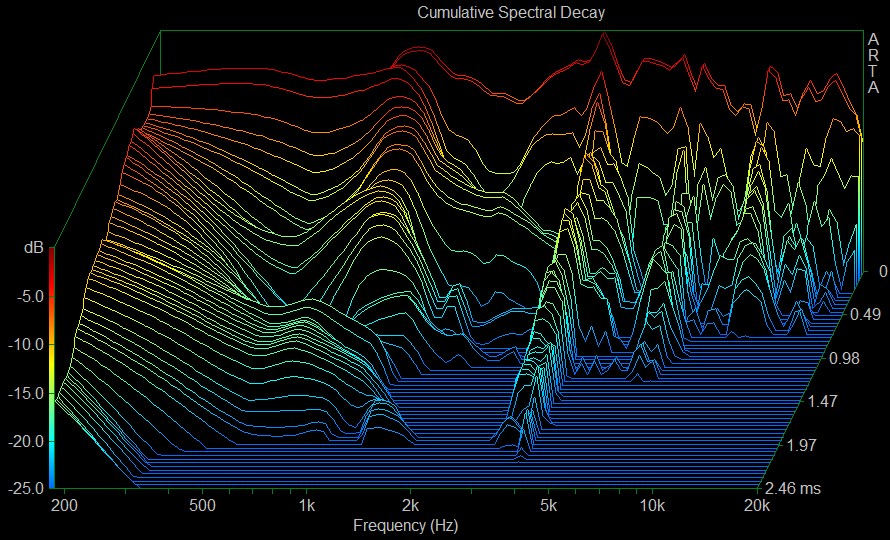
Short-time Fourier Transform (STF)
The Short-Time Fourier Transformation (STF) uses the FFT and Hanning windows to analyze the time-varying spectrum of recorded signals. In general, a larger block shift (1/4 to 1/2 of the FFT length) is used to analyze a larger part of the time-variable signal spectrum, whereby one gets closer to the fields of application such as language and music.
In the STF spectrum, we now also see very nicely the work of the drivers, who in some frequency ranges can afford only very small weaknesses. This "re-drawing" at some frequencies (1.2 KHz, 3.7 KHz) is repeated, with the lower middles at approx. 800 Hz a little too much. The rest is precise and good, though not ultimately outstanding.
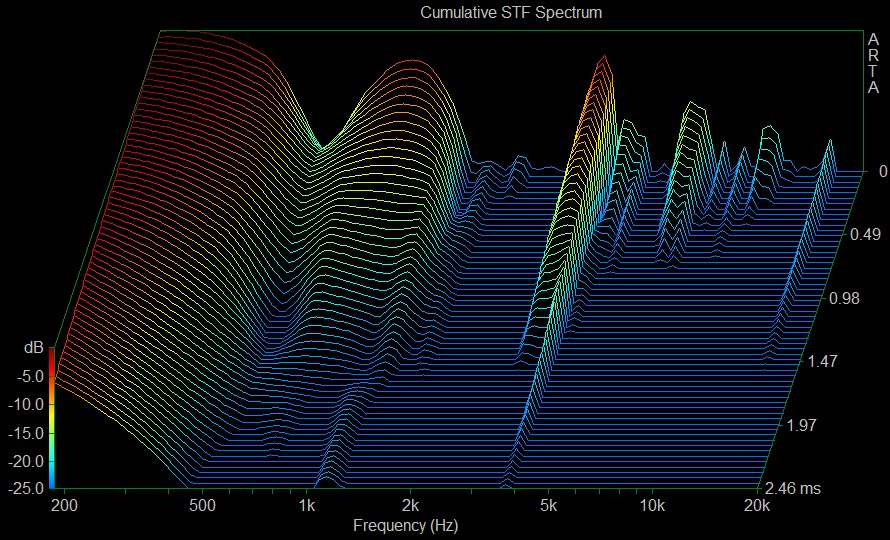
Subjective listening experience
Now let's test subjectively what you get offered in the original. However, as always, I locked the headset in the measuring room for almost 5 days beforehand and tormented it with a selected sound loop to scrub up operating hours. What not to do for our die-hard play fanatics among readers 🙂
Bass
Test the lowest bass in the subcontraoctave (16.4 Hz to 32.7 Hz) with a recording of Bach's Toccata and Fugue in D minor (19 and 25 Hz) and the Festival Overture 1812 by Tchaikovsky (10 Hz and 12.5 Hz). The same applies to the lower ranges of the contraoctothe (32.7 to 65.4 Hz). The big bass drum (kick drum), which in the U-music is a welcome companion and usually on approx. 55 to 60 Hz, this assessment will then be rounded off.
The original bass is clean, precise, crisp and in some situations really raven black, but unfortunately also something to behave for the audiophile music lover. But you can raise the range below 500 Hz again without losing the level strength. So you can make the GSP 600 mutate into a bass bomber, if you think you need it.
But just as the bass still appears in the original, that's fine. Especially when it comes to gaming. However, as an organ lover, you only get the subcontraoctave on your ear if you add at least 6 dB to it. But then the GSP 600 also crumbles.
The upper bass up to 150 Hz, in which also the Great Octave (65.4 to 130.8 Hz) is located, houses the basic language frequency of the male voice and decides very strongly on the true-to-life reproduction of male vocals.
Male vowels seem to be a bit restrained and it is also true for the bass. For gaming, the original sound is perfectly fine, because every impact comes to the ear cleanly and does not overlubricate the rest of the soundscape. Otherwise, in the range of 125 Hz, you can still enjoy approx. 3 dB add more to spice up the fullness a little.
Frequency range
The lower middles (also basic tone range) are approx. 150 to 400 Hz. Together with the already mentioned upper bass, this area plays a very important role for the subjectively perceived heat or bass. Fullness of the sound. The basic language frequency of female voices can be found in this area.
Female vocals also sag slightly, but don't go under. Good, on the other hand, is the precision with which one is directed from the upper bass to the lower middle. This remains quite constant and leaves no holes. The abundance is almost enough and if you like to tune it a bit warmer, you also add 2 to 3 dB. Here you can really choose between cool rendition and homely feel-good ambience. The gamer of the world naturally prefers the ice compartment.
The upper mids between 400 Hz and about two KHz contain a mark at a KHz, which is still considered a reference for many measurements. Unfortunately, this is often noticeable with cheaper devices, as manufacturers often try to overemphasize this frequency. This area does not play an insignificant role in gaming either, and balanced playback contributes significantly to good spatial resolution.
All this becomes more concise, clearer, and yet remains sufficiently precise and differentiated. The depth staggering is good and you can see why a good stereo headset doesn't necessarily have to stink when locating compared to virtual 7.1 spiritism. The sources can still be located sufficiently well even at high levels, whether there is a rumbling from below or not. So far, this has been a very peaceful coexistence of the individual frequency ranges and not a private petty war in the earcup.
High-pitched range
Between two and about 3.5 KHz, human hearing is most sensitive, especially since this area of the lower heights is responsible for the good overtone reproduction of the human voice. This frequency range is crucial for the recognition of a voice or instrument; in this context, one also speaks of the respective timbre.
The voices have a high recognition value, instruments too. What is called timbre is quite close to the original and the headset hardly makes any sense here. The rather neutral interpretation can please and in the end it really has to be emphasized again. All of this has a harmonious effect in itself, without any allures or weaknesses.
The middle heights (3.5 to six KHz) decide on the sound or failure of the speech reproduction as a whole, because the S- and hissing (Sibilants) fall into this range. The upper heights then reach up to approx. ten KHz to move into the super high tone.
The Sibilants are there, though not exuberant. This pleases and prevents slipping into the metallic. Round, balanced and yet present – you don't have to write more. The super high tone also pleases, because nothing goes under or tilts down. The strength of the headset is really in the range above approx. 800 Hz, which certainly plays a lot into the cards of a gamer. Nevertheless, the bass never completely goes under, but is a little further behind in the original vote in the priority list.
Summary and conclusion
I would have liked to have awarded the headset an award for its acoustic benefits, but given the price, the bar is already quite high. The optics, feel, choice of materials, comfort, features and sound of the headphones are quite appropriate for the price. However, the fact that the technical data are so wrong is already quite wrong. It was precisely this contradiction that the post-test could not eliminate. Sound-like, the microphone from the post-test is somehow acceptable, but also not an overflyer, especially since the level is quite low and you need a very good micro-input with level increase. This is where simple solutions on the onboard sound can quickly result in often reported noise.
If you're honest, you have to admit that in this price range, a combination of good stereo headphones and an external microphone is often likely to perform better. The headphone part is very good, you can't stress that often enough, but the microphone is average even after the second test. Here, it is essential that the manufacturer improves if he does not want to push his otherwise very good product into the abyss completely unnecessarily. Because this statement can still be left to stand, albeit attenuated.
For the video fanatics, I also recorded everything with audio-visual fun in the film:
Sennheiser GSP 600 (507263)














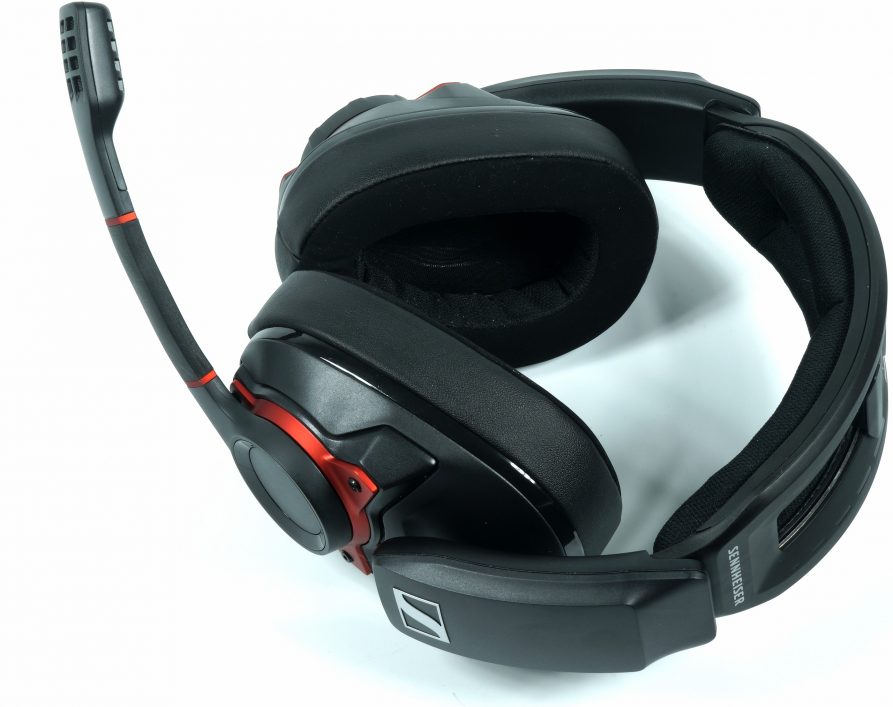

















Kommentieren